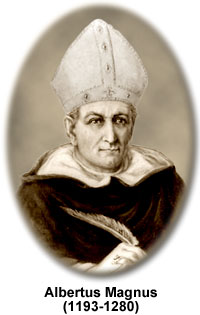Albertus Magnus
(1193-1280)

Albertus Magnus, also known as Albert the Great, was a scholar, philosopher, bishop, and doctor of the Church, as well as the teacher of St. Thomas Aquinas. Canonized in 1931, he was declared the patron saint of the natural sciences, a fitting role considering his tremendous influence in the field.
Albertus was born in Lauingen, Swabia, around the year 1193, although some sources place his date of birth in the thirteenth century. He came from a family that was included among the lower echelons of nobility and was educated at the University of Padua in Italy. Joining the Dominican order of mendicant friars in 1223, Albertus then studied theology in Germany. Later he became the first German Dominican to rise to the master of theology post at the University of Paris. It was there that he was introduced to the works of Aristotle, which were newly translated into Latin from Arabic and Greek. Heavily influenced by the writings, throughout his life Albertus attempted to integrate Aristotelian thought and the philosophy of the Church.
Most likely while still living in Paris, Albertus began a long and prolific career of writing. He composed commentaries of the Bible and the theological textbook Sentences, as well as on all of the works of Aristotle that were available to him. He also began recording the entire body of knowledge contained in the fields of the natural sciences. An astute observer, Albertus not only described and classified information he obtained from other sources, but also often added his own interpretations and beliefs. As he once wrote:
"Science does not consist simply in believing what we are told, but in inquiring into the nature of things."
During his pursuit of science, Albertus touched upon a number of subjects and phenomena, including the nature of light. He was particularly interested in the formation of rainbows and wrote upon the subject with enthusiasm. He also hypothesized that the speed of light was finite though it could travel extremely fast, and examined the darkening action of bright sunlight on crystals of silver nitrate. Furthermore, looking out at the night sky, Albertus determined that the Milky Way was just an immense assembly of stars that received the light of the sun and argued that figures visible on the face of the moon were configurations on its surface, rather than a reflection of the Earth's seas and mountains, as had been previously believed. He also studied the reflection of light through the use mirrors, as well as the refraction capabilities of certain crystals.
A leading scholar of the day, Albertus's examination of optics and other scientific fields was perhaps only exceeded by one of his contemporaries, Roger Bacon. In fact, his deep exploration of the sciences led some to accuse him of neglecting his duties to the Church and others to claim he was involved in necromancy. However, Albertus did not see science and the Church as being in opposition, claiming that real truth was in harmony with both worlds. Through his stringent efforts and voluminous writings he helped legitimatize the combination of reason and religion, paving a safe path for many future scientists to travel.
